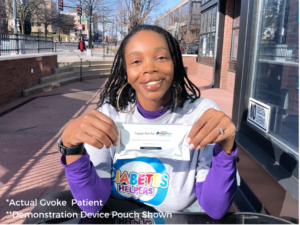 Living with diabetes doesn’t only impact the person who was diagnosed; it impacts close family and friends as well. When I was first told I have diabetes, I didn’t want to tell anyone else. In fact, I started this blog under an alias. I didn’t want people to see me any differently.
Living with diabetes doesn’t only impact the person who was diagnosed; it impacts close family and friends as well. When I was first told I have diabetes, I didn’t want to tell anyone else. In fact, I started this blog under an alias. I didn’t want people to see me any differently.
However, within a couple of weeks of my diagnosis, I realized that I was not being safe. As I returned to work, I understood that people around me needed to know that I had diabetes, take insulin, and could experience hypoglycemia. Hypoglycemia can be life threatening and must be addressed immediately. Because I love to travel, I’ve learned that it’s important that my travel partners know the signs of hypoglycemia and what it looks like for me. Now that I’m a mother, I find it extremely important for my daughter to understand that Mommy has diabetes and that I might need her age-appropriate help at times.
I wasn’t comfortable talking about emergency glucagon with her when she was very young, but now, Gvoke HypoPen® (glucagon injection) has changed the game for me and I’m so glad. I feel completely comfortable explaining to my 7-year-old daughter how to give me glucagon and I’m thankful for this advancement in technology. The clear instructions and non-intimidating delivery mechanism of Gvoke HypoPen® help me feel safer in my home. Now, I know that if I develop severe hypoglycemia, every single person in my home can assist me.
These are the steps to use Gvoke HypoPen®:
- Step 1 – Pull off the red cap.
- Step 2 – Push the yellow end down on exposed skin of the upper arm, stomach, or thigh, and hold.
- Step 3 – Continue to hold down and slowly count to 5 to make sure you receive the full dose. A part of the medication viewing window will turn red.
Gvoke HypoPen® makes it simpler to teach family, friends, and travel buddies about glucagon. I didn’t know anything about glucagon before I was diagnosed, and I think most people are like the old, uninformed me (unless they’ve known someone with diabetes). I’ve found that the more I open up to others about the details of daily diabetes management, the more understanding people are. I have gone from not wanting to tell anyone I’m diabetic to becoming an awareness advocate!
I’d say Gvoke HypoPen® is one diabetes innovation worth bragging about. If you also would like a glucagon that you can easily explain to friends and family, I recommend you talk to your healthcare professional about Gvoke HypoPen®.
INDICATION AND SAFETY SUMMARY
GVOKE is a prescription medicine used to treat very low blood sugar (severe hypoglycemia) in adults and kids with diabetes ages 2 years and above. It is not known if GVOKE is safe and effective in children under 2 years of age.
WARNINGS
Do not use GVOKE if:
- you have a tumor in the gland on top of your kidneys (adrenal gland), called a pheochromocytoma.
- you have a tumor in your pancreas called an insulinoma.
- you are allergic to glucagon or any other inactive ingredient in GVOKE.
GVOKE MAY CAUSE SERIOUS SIDE EFFECTS, INCLUDING:
High blood pressure. GVOKE can cause high blood pressure in certain people with tumors in their adrenal glands.
Low blood sugar. GVOKE can cause low blood sugar in certain people with tumors in their pancreas called insulinomas by making too much insulin in their bodies.
Serious allergic reaction. Call your doctor or get medical help right away if you have a serious allergic reaction including:
- rash
- difficulty breathing
- low blood pressure
COMMON SIDE EFFECTS
The most common side effects of GVOKE in adults include:
- nausea
- vomiting
- swelling at the injection site
- headache
The most common side effects of GVOKE in children include:
- nausea
- low blood sugar
- high blood sugar
- vomiting
- abdominal pain
- headache
- pain or redness at the injection site
- itching
These are not all the possible side effects of GVOKE. For more information, ask your doctor.
Call your doctor for medical advice about side effects. You are encouraged to report side effects of prescription drugs to the FDA. Visit www.fda.gov/medwatch, or call 1-800-FDA-1088.
BEFORE USING
Before using GVOKE, tell your doctor about all your medical conditions, including if you:
- have adrenal gland problems
- have a tumor in your pancreas
- have not had food or water for a long time (prolonged fasting or starvation)
- have low blood sugar that does not go away (chronic hypoglycemia)
- are pregnant or plan to become pregnant
- are breastfeeding or plan to breastfeed
Tell your doctor about all the medicines you take, including prescription and over-the-counter medicines, vitamins, and herbal supplements.
HOW TO USE
- Read the detailed Instructions for Use that come with GVOKE.
- Use GVOKE exactly how your healthcare provider tells you to use it
- Make sure your relatives, close friends, and caregivers know where you store GVOKE and how to use it the right way before you need their help.
- Act quickly. Having very low blood sugar for a period of time may be harmful.
- Your healthcare provider will tell you how and when to use GVOKE.
- After giving GVOKE, your caregiver should call for emergency medical help right away.
- If you do not respond after 15 minutes, your caregiver may give you another dose, if available. Tell your healthcare provider each time you use GVOKE. Low blood sugar may happen again after receiving an injection of GVOKE. Your diabetes medicine may need to be changed.
HOW TO STORE
- Keep GVOKE in the foil pouch until you are ready to use it.
- Store GVOKE at temperatures between 68°F and 77°F.
- Do not keep it in the refrigerator or let it freeze.
Keep GVOKE and all medicines out of the reach of children.
For more information, call 1-877-937-4737 or go to www.GvokeGlucagon.com.
Please see the Full Prescribing Information for Gvoke.





I was an early adopter of BAQSIMI which after 43 years Sheryl was actually willing (and able) to administer. 43 years and countless attempts to help her understand how to do it, no way would she give it. I use a pump that notifies her of everything and she would never push the shot.Finally she can do something about diabetes where she is in control.